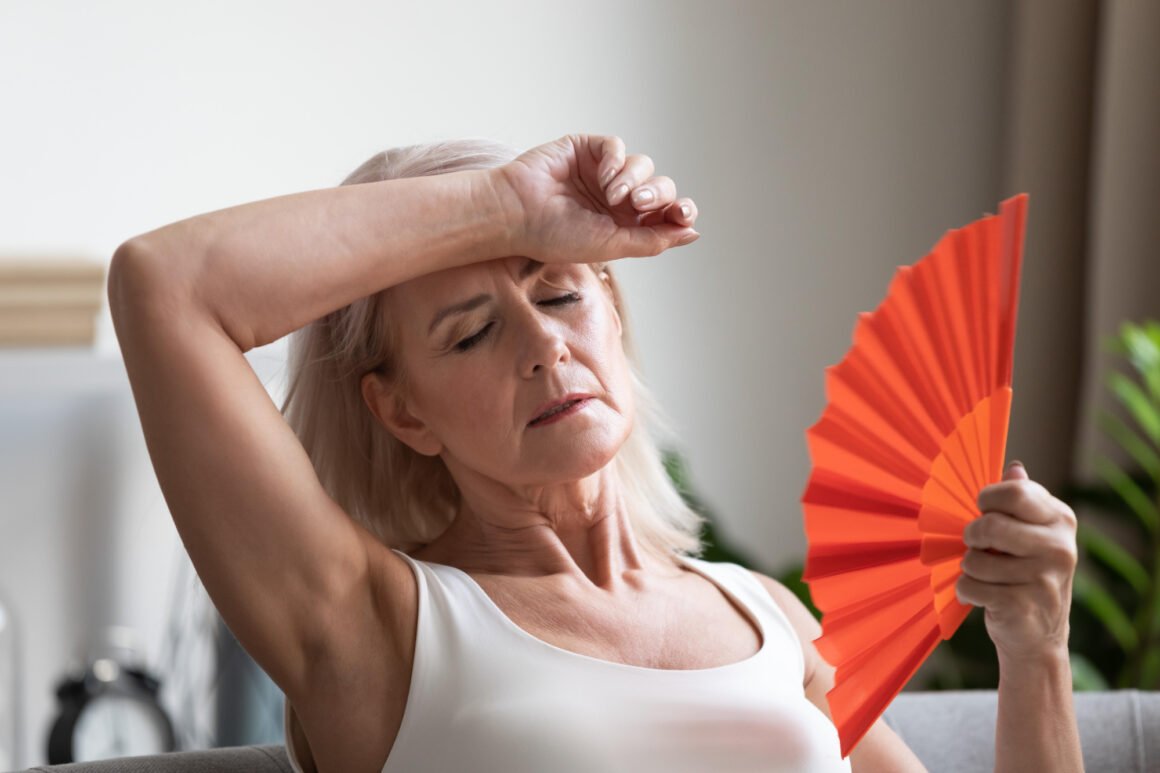What are hot flushes and why do they occur during menopause?
As women navigate the transition into menopause, one of the most common and disruptive symptoms they encounter is hot flushes. These sudden feelings of intense heat, often accompanied by sweating and a rapid heartbeat, can significantly impact daily life and overall well-being.
Hot flushes are a physiological response triggered by hormonal fluctuations that occur during the menopausal years. As the ovaries gradually reduce their production of oestrogen, the body’s thermoregulatory system becomes imbalanced, leading to these episodes of intense heat and sweating.
While the exact mechanisms behind hot flushes are not fully understood, researchers believe that the declining levels of oestrogen affect the hypothalamus, the part of the brain responsible for regulating body temperature. This disruption in the body’s temperature control can cause blood vessels to dilate, leading to a sudden rush of heat and sweating.
Symptoms and triggers of hot flushes
Hot flushes can manifest in various ways and can be influenced by different factors. The primary symptoms include:
- A sudden feeling of intense heat, often concentrated in the upper body, face, and chest
- Flushing or reddening of the skin, particularly on the face, neck, and chest
- Sweating, which can range from mild perspiration to drenching sweats
- Rapid heartbeat or palpitations
- Chills or shivering following the hot flush episode
Certain triggers can increase the likelihood or intensity of hot flushes, including:
- Stress and emotional factors
- Caffeine and alcohol consumption
- Spicy foods
- Warm environments or sudden changes in temperature
- Smoking
- Certain medications
It’s essential to recognize these triggers and make appropriate lifestyle adjustments to minimize their impact.
The impact of hot flushes on daily life
Hot flushes can have a profound effect on a woman’s daily life, impacting various aspects such as:
- Sleep disturbances: Night sweats and hot flushes can disrupt sleep patterns, leading to insomnia, fatigue, and decreased productivity during the day.
- Emotional well-being: The unpredictability and intensity of hot flushes can cause frustration, anxiety, and even depression in some women.
- Social interactions: Feeling self-conscious or embarrassed about visible sweating or flushing can limit social engagement and impact relationships.
- Work performance: Concentration difficulties and fatigue resulting from hot flushes can affect work productivity and professional interactions.
- Physical discomfort: The sudden onset of heat, sweating, and rapid heartbeat can be physically uncomfortable and disruptive.
Recognizing the impact of hot flushes is crucial for developing effective coping strategies and seeking appropriate support.
Expert tips for managing hot flushes
While hot flushes are a natural part of the menopausal transition, there are various strategies and techniques that can help manage their frequency and severity. Here are some expert tips:
- Keep a symptom diary: Track the occurrence, duration, and potential triggers of hot flushes to identify patterns and develop personalized management strategies.
- Practice deep breathing exercises: Slow, deep breaths can help regulate body temperature and promote relaxation during a hot flush episode.
- Stay hydrated: Drinking plenty of water can help regulate body temperature and alleviate some of the discomfort associated with hot flushes.
- Dress in layers: Wearing lightweight, breathable layers of clothing can help you adjust your body temperature more easily during a hot flush.
- Use cooling techniques: Keep a portable fan or cooling towels nearby to help alleviate the sensation of heat during a hot flush.
- Manage stress levels: Engage in stress-reducing activities like yoga, meditation, or deep breathing exercises, as stress can exacerbate hot flushes.
- Seek support: Join a support group or talk to a healthcare professional to learn more effective coping strategies and find emotional support.
Lifestyle changes to reduce the frequency and severity of hot flushes
Adopting a healthy lifestyle can play a significant role in managing hot flushes during menopause. Consider the following lifestyle modifications:
- Exercise regularly: Regular physical activity, such as brisk walking, swimming, or cycling, can help regulate body temperature and reduce the frequency and intensity of hot flushes.
- Maintain a healthy weight: Carrying excess body weight can increase the risk and severity of hot flushes. Aim for a balanced diet and regular exercise to achieve a healthy body weight.
- Quit smoking: Smoking has been linked to an increased risk and severity of hot flushes. Quitting smoking can help alleviate this symptom.
- Manage stress levels: Chronic stress can exacerbate hot flushes. Incorporate stress-reducing activities like meditation, yoga, or deep breathing exercises into your daily routine.
- Get enough sleep: Lack of sleep can worsen hot flushes. Establish a consistent sleep routine and create a cool, comfortable sleeping environment.
- Avoid triggers: Identify and avoid potential triggers, such as spicy foods, caffeine, alcohol, and hot environments, which can exacerbate hot flushes.
Dietary recommendations for managing hot flushes
What you eat can also impact the frequency and severity of hot flushes. Consider incorporating the following dietary recommendations:
- Increase your intake of plant-based foods, such as fruits, vegetables, whole grains, and legumes, which are rich in phytoestrogens and antioxidants.
- Consume foods rich in calcium and vitamin D, such as dairy products, leafy greens, and fortified foods, to support bone health during menopause.
- Include foods high in omega-3 fatty acids, like fatty fish, walnuts, and flaxseeds, which may help reduce inflammation and alleviate hot flushes.
- Stay hydrated by drinking plenty of water and avoiding excessive caffeine and alcohol, which can trigger hot flushes.
- Limit your intake of processed foods, sugary snacks, and refined carbohydrates, as they can contribute to weight gain and exacerbate hot flushes.
Natural remedies and alternative therapies for hot flushes
In addition to lifestyle changes and dietary modifications, some women find relief from hot flushes through natural remedies and alternative therapies. These include:
- Herbal supplements: Certain herbs, such as black cohosh, evening primrose oil, and ginseng, have been traditionally used to alleviate menopausal symptoms like hot flushes. However, it’s essential to consult with a healthcare professional before taking any supplements, as they can interact with medications or have side effects.
- Mind-body practices: Techniques like yoga, meditation, and deep breathing exercises can help promote relaxation and reduce stress, which may alleviate hot flushes.
- Acupuncture: This ancient Chinese practice involves the insertion of thin needles into specific points on the body to promote energy flow and balance. Some studies suggest that acupuncture may help reduce the frequency and severity of hot flushes.
- Hypnotherapy: Hypnotherapy aims to induce a state of deep relaxation and focus, which may help manage hot flushes by reducing stress and promoting a sense of control.
- Aromatherapy: Essential oils like peppermint, clary sage, and lavender are believed to have cooling and calming properties that may help alleviate hot flushes. However, it’s important to use essential oils safely and consult with a qualified practitioner.
Hormone replacement therapy and other medical interventions for hot flushes
In some cases, lifestyle modifications and natural remedies may not provide sufficient relief from hot flushes. In such instances, medical interventions may be recommended by a healthcare professional. These include:
- Hormone replacement therapy (HRT): HRT involves taking synthetic hormones, such as oestrogen or a combination of oestrogen and progestin, to help alleviate menopausal symptoms like hot flushes. HRT is an effective treatment option but may carry risks, so it’s essential to discuss the benefits and potential side effects with a healthcare provider.
- Non-hormonal medications: Certain non-hormonal medications, such as low-dose antidepressants or gabapentin, may help reduce the frequency and severity of hot flushes in some women.
- Bioidentical hormone therapy: This approach involves using hormones that are chemically identical to those produced naturally by the body. While some women find relief with bioidentical hormones, more research is needed to establish their safety and efficacy.
- Prescription medications: In severe cases, healthcare providers may prescribe medications specifically designed to target and alleviate hot flushes, such as paroxetine or clonidine.
It’s crucial to discuss the potential benefits, risks, and side effects of any medical intervention with a qualified healthcare professional to determine the most appropriate course of action.
Coping mechanisms and support systems for dealing with hot flushes
Managing hot flushes can be a challenging and emotional journey. Developing effective coping mechanisms and seeking support can help women navigate this transition more positively:
- Practice self-care: Engage in activities that promote relaxation and well-being, such as taking a warm bath, practicing mindfulness, or pursuing a hobby you enjoy.
- Seek emotional support: Connect with friends, family members, or a support group to share experiences and receive encouragement.
- Educate yourself: Learn about the menopausal transition and hot flushes by reading reputable sources or attending educational seminars or workshops.
- Consider counseling: If hot flushes are causing significant emotional distress, seeking professional counseling or therapy can provide valuable coping strategies and support.
- Be patient and kind to yourself: Recognize that hot flushes are a natural part of the menopausal transition and that it’s essential to be patient and compassionate with yourself during this time.
Conclusion: Taking control of hot flushes and embracing menopause as a new chapter in life
Hot flushes can be a challenging and disruptive symptom of menopause, but with the right strategies and support, women can take control and manage them effectively. By adopting a combination of lifestyle changes, dietary modifications, natural remedies, and medical interventions (when necessary), it’s possible to reduce the frequency and severity of hot flushes and minimize their impact on daily life.
Remember, menopause is a natural transition, and hot flushes are a common experience shared by many women. Embracing this new chapter with a positive mindset, seeking support, and prioritizing self-care can help women navigate this journey with greater ease and confidence.
If you’re struggling with hot flushes or other menopausal symptoms, don’t hesitate to consult with a healthcare professional or join our supportive community of women going through similar experiences. Visit our website at to access valuable resources, connect with others, and find the support you need to manage hot flushes and embrace this new phase of life with confidence and empowerment.




